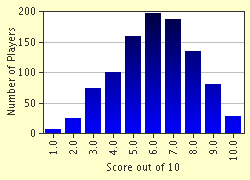Quiz Answer Key and Fun Facts
1. Who was the English King who was killed by 'the little gentleman in the black velvet'?
2. Of which of these did Edward VIII become the Governor after he abdicated from the British throne?
3. Which famous Englishman was killed by a musket-ball fired from aboard the French ship "Redoutable" on 21st of October 1805?
4. What happened on 8th August 1963 that shocked public opinion in Britain?
5. Which of these plots led to the execution of Mary Queen of Scots?
6. Which of these ancient medieval castles was and, still is, the largest ever built in Britain?
7. How did the London baker Thomas Farriner aka Thomas Farynor aka Thomas Faynor get into the history books in 1666?
8. Which of these palaces was Queen Victoria's Palace on the Isle of Wight?
9. Which part of the British Isles was once ruled by the Kings of Alba?
10. Which of these historic characters once had to hide in an oak tree to save his life after a military defeat?
Source: Author
flem-ish
This quiz was reviewed by FunTrivia editor
bloomsby before going online.
Any errors found in FunTrivia content are routinely corrected through our feedback system.

